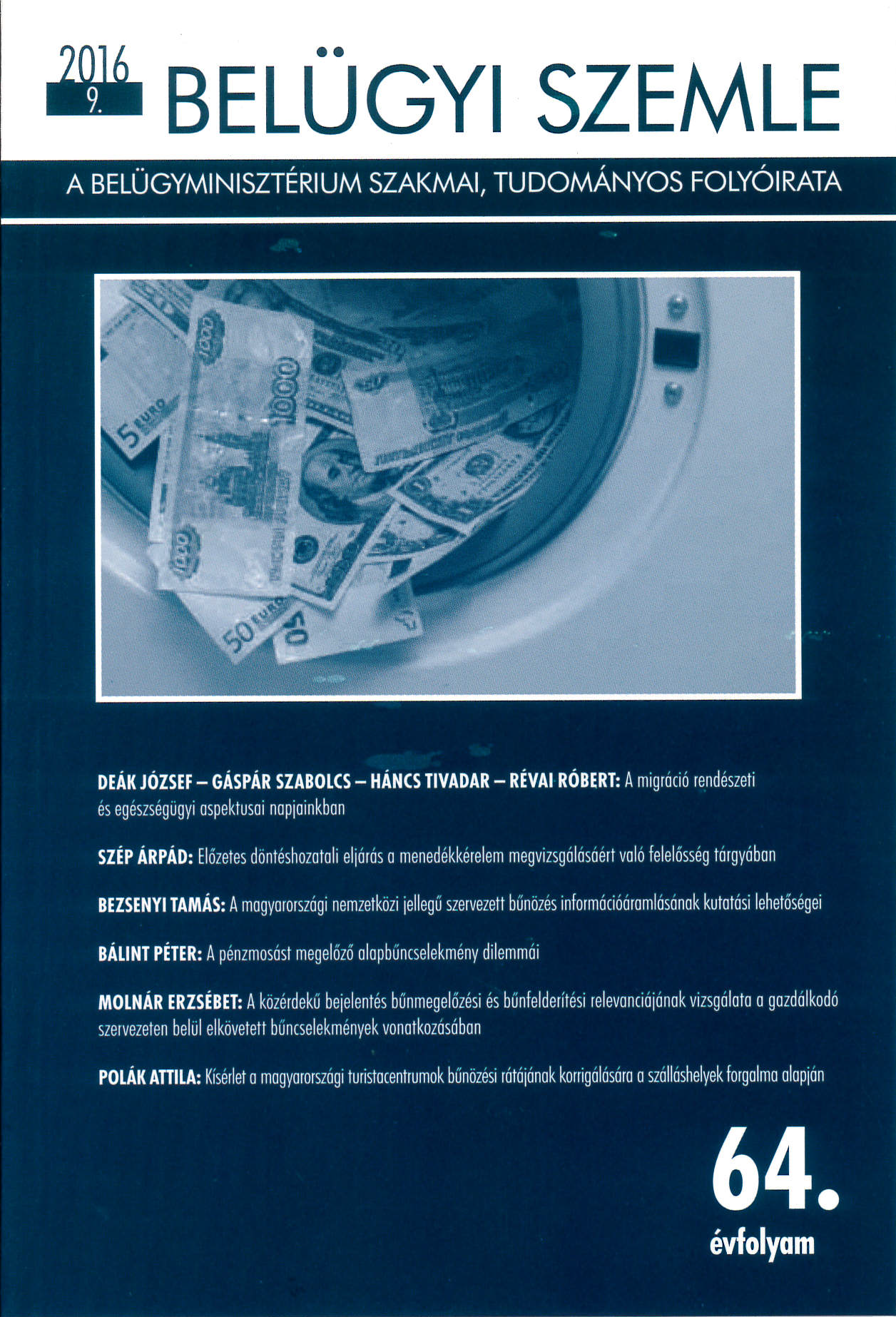Keywords
crime
evidence
Hungary
evidence
Hungary
How to Cite
The role of line-up and digital data in a specific indidency case. (2016). Academic Journal of Internal Affairs, 64(9), 119-129. https://doi.org/10.38146/BSZ.2016.9.7
Abstract
Through the presentation of a specific case, the author provides an overview of the role of presenting evidence, and line-up in criminal investigations in Hungary.
Downloads
Download data is not yet available.
Similar Articles
- Máté Sivadó, Radical decrease in the number of homicides in Hungary , Academic Journal of Internal Affairs: Vol. 69 No. 4. ksz. (2021): Különszám
- Orsolya Czenczer, Pandemic – a shift of paradigm in the prison service. International perspective and presentation of Hungarian best practices , Academic Journal of Internal Affairs: Vol. 69 No. 5. ksz. (2021): Különszám
- Judit Szabó, György Virág, Love in the Time of Pandemic. Domestic violence during the first wave of COVID-19 in Hungary , Academic Journal of Internal Affairs: Vol. 70 No. 1. ksz. (2022): Special Issue
- Valér Dános, Anita Varga, Csaba Szabó, About János Sallai’s book entitled The Establishment and Accreditation of Law Enforcement Science in Hungary, with special emphasis on the chapters dealing with impact of professional journals on the develo , Academic Journal of Internal Affairs: Vol. 70 No. 4 (2022)
- József Boczán, Federal agents in Hungary , Academic Journal of Internal Affairs: Vol. 70 No. 7 (2022)
- Zsolt Lippai, Erna Uricska, Tamás Nagy, The protection of very important persons in Hungary – the legislation of personal protection from 1997 to the present day , Academic Journal of Internal Affairs: Vol. 70 No. 2. ksz. (2022): Special Issue
- Vince Vári, Crimes related to new psychoactive substances in rural segregates of Miskolc in Hungary , Academic Journal of Internal Affairs: Vol. 70 No. 2. ksz. (2022): Special Issue
- Zsolt Pádár, Mónika Nogel, Gábor Kovács, Gergely Gárdonyi, Petra Zenke, Special Challenges of Wildlife Forensics in Hungary , Academic Journal of Internal Affairs: Vol. 70 No. 9 (2022)
- Előd Hidvégi, Gábor Süvegh, The 150-year history of the first forensic institute in Hungary , Academic Journal of Internal Affairs: Vol. 71 No. 7 (2023)
- Balázs Márton , Open-source intelligence (OSINT) as an opportunity in the investigation of crimes , Academic Journal of Internal Affairs: Vol. 71 No. 8 (2023)
You may also start an advanced similarity search for this article.
Most read articles by the same author(s)
- Csaba Fenyvesi, The second version of the criminalist pyramid-model , Academic Journal of Internal Affairs: Vol. 62 No. 9 (2014)
- Csaba Fenyvesi, Justizmord and investigative errors , Academic Journal of Internal Affairs: Vol. 62 No. 3 (2014)
- Csaba Fenyvesi, Crime Prevention Function of Criminalistics , Academic Journal of Internal Affairs: Vol. 69 No. 10 (2021)
- Csaba Fenyvesi, Jack the Ripper and modern forensic methods , Academic Journal of Internal Affairs: Vol. 65 No. 7-8 (2017)
- Csaba Fenyvesi, Presentation for recognition and faith , Academic Journal of Internal Affairs: Vol. 66 No. 4 (2018)
- Csaba Fenyvesi, József Orbán, Electronic data as a cornerstone of the 7-5-1 forensic pyramid model , Academic Journal of Internal Affairs: Vol. 67 No. 2 (2019)
- Csaba Fenyvesi, Global trends in forensic science in the 21st century , Academic Journal of Internal Affairs: Vol. 61 No. 10 (2013)
- Csaba Fenyvesi, Every police organization is only as good as its data , Academic Journal of Internal Affairs: Vol. 70 No. 11 (2022)
- Csaba Fenyvesi, Concepts and academic approaches in criminal investigation in continental and common law , Academic Journal of Internal Affairs: Vol. 63 No. 2 (2015)
- Csaba Fenyvesi, Ferenc Kodba, Criminalistic Turns of the Murder Case in Pécs on Palahegyi Street in 1974 , Academic Journal of Internal Affairs: Vol. 68 No. 4 (2020)

